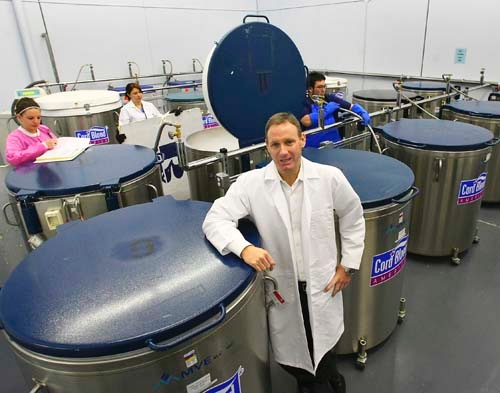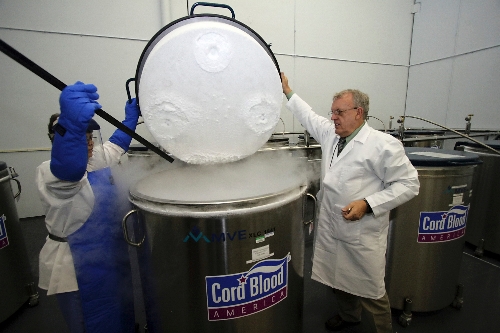Cord Blood America still struggles to make money
Cord Blood America Inc.'s shares were struggling enough last year that getting to a penny a share would have marked a major improvement. So executives at the Las Vegas-based company turned to the infrequently used reverse split as a solution.
In May 2011, each 100 existing shares were swapped for one new share, lowering the total share count to 68.1 million from 6.8 billion.
"Cord Blood America has a golden opportunity in front of it, an opportunity to get over the hump to cash flow positive and profitability," former Chairman and CEO Matthew Schissler said in a video posted on YouTube before the split. "And in order to do so, we need a (capital) structure that attracts strategic investors ... one that has a higher share price."
The promise has yet to pan out.
Cord Blood, which stores umbilical cord blood as a noncontroversial source of stem cells for medical treatment, is valued at about 1 cent a share, its lowest in at least five years when prices are adjusted for the split. The company's share count has risen to 209.1 million as of March and is still climbing because of the issuance of a type of debt sometimes called a death-spiral convertible.
After eight years in business, the company has never made a profit. And there is little to suggest that will change. Schissler, who took control of the company in 2003 when it was just a shell, resigned without explanation May 15.
Joseph Vicente, who has replaced Schissler at Cord Blood CEO after eight years with the company, declined to comment about the company's prospects.
"At this point, we will stand on what we say in public releases and regulatory filings," he said.
In its first-quarter report, Cord Blood forecast that it could generate operating profits over the coming year though a combination of lower spending, including cuts in its 19-member staff, and by boosting revenues from existing operations.
For all of 2011, revenues of $5.7 million marked a 37 percent gain from 2010, as the company reported growth in the United States, Europe and South America. Cord Blood now has about 30,000 blood samples in storage.
In 2011, Cord Blood's net loss narrowed 26 percent to $6 million from $8.1 million a year earlier.
During the first quarter, the net loss shrank to $1.29 million from $1.85 million the previous year, as revenues rose 6.8 percent to $1.56 million from $1.46 million. Cord Blood's cumulative loss throughout its existence has now passed $50 million, creating a reliance on cash infusions from various entities to keep a weak balance sheet from collapsing.
Nevertheless, Cord Blood remains a hotly traded Over-The-Counter Bulletin Board stock. On an average day, 828,000 shares - worth about $8,200 - change hands. Before the split, the daily volume occasionally exceeded 1 billion, which Schissler once termed a testament to investor confidence in the company.
One securities expert, who asked not to be identified, noted that participants in Internet chat rooms and on sites that recommend stocks have kept alive the hope that investors can make big profits with little money up front.
For example, topstockpicks.com reiterated its rating of Cord Blood as one of its top three penny stocks for this year. The note was posted in January, when the price spiked above 4 cents a share one day. It has fallen since then.
AN EAGER GREETING
When Cord Blood moved to Las Vegas in 2009 it was hailed as a trophy by state economic development officials eager to diversify into the sciences.
"We won an incredible company," Nevada Development Authority CEO Somer Hollingsworth said in 2010, as he recounted efforts to persuade Cord Blood to move from Santa Monica, Calif.
He could not be reached for comment Friday.
Those efforts included a package of tax abatements and deferrals based on how much the company invests in the state. Hollingsworth could not be reached Friday for additional comment.
Schissler was named chairman of authority's biotech committee, even though his background was in broadcast media advertising and sales at a personnel agency.
The basic concept behind Cord Blood America has been around for years but has yet to gain wide acceptance.
Umbilical cord blood was once considered medical waste after a birth. However, the blood is a rich source of stem cells, a cornerstone of human life that can divide into the wide array of cells in a body.
Companies such as Cord Blood America, which operates under the name CorCell, sell parents on the idea that the blood should be saved - supercooled by liquid nitrogen for as long as 18 years - to provide healthy cells for medical treatment if their baby or a relative develops certain diseases or medical conditions.
"This significantly reduces the critical time to start treatment," CorCell said on its website. "And there are no rejection issues - dramatically increasing the chances of a successful transplant."
Further, banking blood avoids controversies associated with stem cell research that uses cells from aborted fetuses. Using banked blood can be much less of a physical ordeal for a patient than a bone-marrow transplant, an alternate method for correcting stem cell-related problems.
Still, medical professionals have not embraced blood banking, and in 2007 the American Academy of Pediatrics took the position that there is no value in banking blood as biological insurance. If parents decide to store blood, the academy recommended using a nonprofit bank, so a wider range of people might benefit, instead of a for-profit one such as Cord Blood America, in which blood is reserved for the donor and people specifically designated.
The American College of Obstetricians and Gynecologists estimated the chance of a child or close family member needing a stem cell transplant at 1 in 2,700. Blood banking make sense only if a full sibling has a problem that stem cells currently can cure, it said in 2008.
Doctors have also weighed into the issue because of expense. Cord Blood charges $2,075 for the first year, plus another $125 each year the blood remains in storage. A program the company launched called Afford-A-Cord reduces the upfront payment to $645, then charges $19 a month on an unspecified contract term.
Afford-A-Cord ranked as the most expensive option, at $5,055 over two decades, among the 18 storage banks ranked by the Parent's Guide to Cord Blood Foundation.
PROPPING UP CASH FLOW
With widespread competition in the U.S. and other countries, Cord Blood has run up a nonstop string of losses since buying a storage business in Florida eight years ago. As a result, the company has frequently resorted to outsiders to prop up cash flow.
Cord Blood has frequently turned to convertible debentures, in which a company borrows money and promises to repay the loan with either cash or newly issued stock. A typical convertible debenture includes a fixed price for the stock, so if it performs poorly, the lender loses.
The variant Cord Blood and other weakly capitalized companies use includes a floating price that gives the lender a discount to the market value, so lenders can quickly sell the shares at a profit in lieu of repayment.
There is no limit on the number of shares that can be issued.
Nasdaq's website defined that type of debenture, commonly known as a death-spiral convertible, as one "used by companies that are in such bad shape that there is no other way to get financing. ... The further the stock falls, the more shares (lenders) get."
In Cord Blood's case, this meant putting out a gusher of new shares, raising the total from 141.9 million shares at the end of 2007 to 6.8 billion last year. This diluted the value of existing shareholders' holdings enough that the stock was trading at about one-tenth of a cent.
The reverse split in 2011 brought temporary relief, reducing the number of shares by 90 percent. But other death-spiral debentures restarted the dilution.
On Friday, the company sold $1.25 million in debentures that allow repayment in stock to Tonaquint Inc., a Utah corporation.
Contact reporter Tim O'Reiley at
toreiley@reviewjournal.com
or 702-387-5290.


















